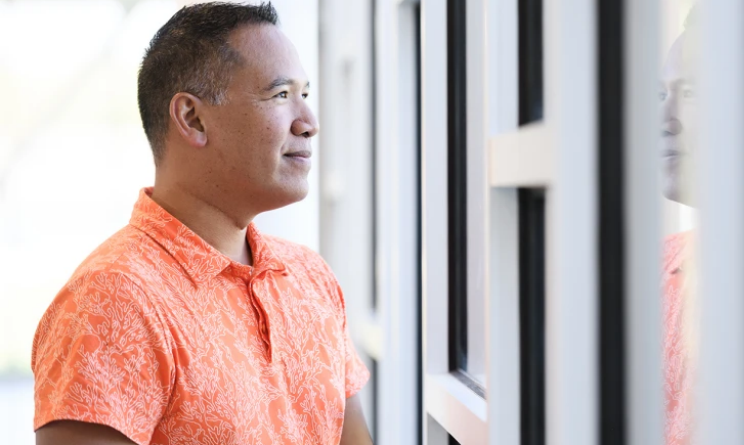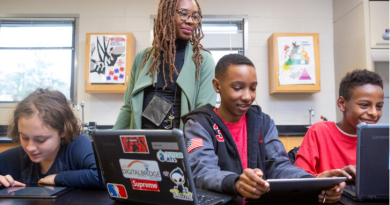Rural Districts Get Creative Amid a Spike in Students’ Mental Health Needs
Principal Jonathan A.C. Apostol stands for a portrait at Monett Middle School in Monett, Mo., on Sept. 29, 2023. The school started investing in student mental health services before the COVID-19 pandemic, and its new building includes a designated area for mental health counselors that doubles as a calming space for students.
If you or anyone you know is struggling with thoughts of self-harm or suicide, help is available. Call or text 988 to reach the confidential National Suicide Prevention Lifeline or check out these resources from the American Foundation for Suicide Prevention.
The COVID-19 pandemic has brought mental health crises to the forefront of public attention. But Jonathan Apostol, principal of Monett Middle School near the southwest corner of Missouri, was well acquainted with the challenge before the first virus cases made it to his community.
Between 2019 and 2021, his district lost three of its community members—a 14-year-old student, a superintendent, and a guidance counselor—to suicide. The suicides were a shock to Monett, a town of 9,000 with just over 2,300 students, Apostol said.
The tragedies came just as the district was beginning to invest in mental health services, and years before the U.S. Surgeon General labeled worsening youth mental health “the defining public health crisis of our time.” For the past five years, the school district has partnered with Clark Community Mental Health Center, an organization that provides mental health and substance use services to people in Monett and surrounding communities.
Counselors from the center work with the district to assess students who may be exhibiting signs of mental health issues, provide in-school therapy, help students in crisis access care, and educate the community about the signs of suicide risk and other mental health problems. This school year, the middle school moved into a newly constructed building with a designated office area for the center’s counselors to work with students. It also serves as a calm space where students can go when they’re feeling overwhelmed.
The partnership has allowed the school to quickly get students connected to care when they’re in a crisis and has created stronger partnerships among the community, the school, and local mental health providers.
But all of those services hinge on the community mental health center, a resource that isn’t available in most rural and small communities.
“We’re kind of an anomaly,” Apostol said. “We’re rural and small, but we’re very fortunate to have those resources there. I do worry about our school districts where the mental health or the extended therapeutic services for our students are 30 minutes to an hour away.”
While many large, urban districts have leveraged partnerships with nearby hospitals and university systems to get more mental health support into their schools, rural districts are left to conjure creative solutions to a mental health crisis that isn’t sparing smaller communities. Staffing shortages and low funding have become barriers to providing desperately needed services, all while students’ mental health deteriorates, affecting their well-being and academic performance.

The pandemic’s impact
Greg Zenion, principal of the 900-student Chariho Middle School in Wood River Junction, R.I., has noticed a massive shift in his students’ behavior following the COVID-19 pandemic. The longtime principal has seen higher rates of anxiety and depression, with students requiring more intensive counseling than his school is able to provide.
“They’re completely dysregulated,” Zenion said. “I see behaviors that I never saw before. They’re very immature. They’re very antisocial. They go from zero to 100 with exploding. They have no patience anymore. They don’t communicate anymore. And they have tantrums.”
Zenion’s students aren’t an anomaly. Every rural school leader interviewed for this article said their students are struggling more with their mental health and behavior than they used to, and national studies have shown that youth are experiencing record rates of depression and anxiety.
In 2021, 42 percent of high school students said they experienced persistent feelings of sadness or hopelessness over the past year, according to the U.S. Centers for Disease Control and Prevention’s Youth Risk Behavior Survey. And rural communities have seen especially high rates of suicide, with suicides increasing 46 percent from 2000 to 2020 in non-metro areas compared to 27.3 percent in metro areas.
“What the pandemic did for everybody, including students around here, was decrease certainty,” said Chase Christensen, superintendent of Sheridan County School District #3 in Clearmont, Wyo., which serves 96 students. “When we’re living in an environment of decreased certainty, it’s added stress. It creates a stress point in every decision we make. That gets felt in the workplace, it gets felt in our personal lives, but the students are feeling that especially.”
Everyone thinks rural is quaint and beautiful and quiet. What I don’t think people fully understand is we have some of the same issues as urban [schools], but we just don’t have the same resources.
Educators can’t keep up with the needs. Both Christensen and Zenion, for example, have struggled to keep mental health worker positions at their schools filled.
For Zenion, in Rhode Island, there’s funding for two social workers and a psychologist at his school, but he went all of last school year with an open social worker position.
He was finally able to hire a social worker in June, but by then, the school psychologist had become burned out from having to make up for the extra work and resigned, leaving the school without a psychologist at the start of this academic year. Even if the school was operating with a fully staffed mental health team, Zenion doesn’t think it would be enough to meet students’ needs.
“Everyone thinks rural is quaint and beautiful and quiet,” Zenion said. “What I don’t think people fully understand is we have some of the same issues as urban [schools], but we just don’t have the same resources.”
Outside resources like a major clinic or hospital system are often unavailable in rural communities. Clearmont, in northeast Wyoming near the Montana border, doesn’t have any mental health practitioners, and the nearest town where a student might be able to see someone is at least a half-hour away.
“When a student’s struggling mental health-wise and then takes time away from their class, it builds up pressure of, ‘Now I’ve got work to make up,’ and it puts them behind the ball, which adds more stress and creates a negative downward spiral,” Christensen said.
Finding solutions
While rural and small schools don’t have the same resources as large, urban districts, they have still found ways to make mental health a priority.
Christensen’s district has invested in Sources of Strength, a suicide prevention program that helps students and staff identify signs that someone is struggling. The district also started offering a $1,000 reimbursement to all of its staff members to help cover the costs of physical or mental wellness, including therapy, gym memberships, and doctor visits.
Another Wyoming principal, Ben Carr of the 246-student Mountain View High School near the Utah border, has invested in suicide prevention efforts in addition to contracting with two mental health providers who visit the school to work with students.
But one of the most important initiatives, Carr said, has been social-emotional learning, training Mountain View’s school counselors so they can work with students on managing their emotions, cultivating healthy relationships, and mastering other life skills. Researchers have found that social-emotional learning, implemented well, improves students’ coping skills, which can lessen symptoms of anxiety and depression. They’ve also found that such instruction can improve young people’s attitudes about themselves.
Source: https://www.edweek.org/leadership/rural-districts-get-creative-amid-a-spike-in-students-mental-health-needs/2023/10




